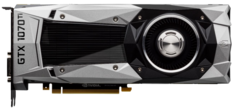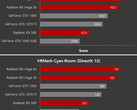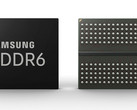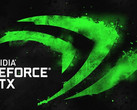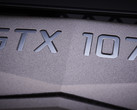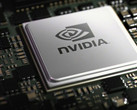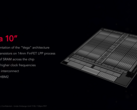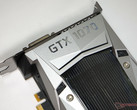Just in time for the games scheduled to launch this holiday season, NVIDIA has announced the launch of a new addition to its Pascal line of GPUs — the GeForce GTX 1070 Ti. NVIDIA claims that the 1070 Ti offers upto 2x the performance of its direct predecessor, the GTX 970. Squashing earlier reports, which claimed that the 1070 Ti will not enable overclocking, NVIDIA has announced that the new card offers enough headroom to push it beyond the boost clocks. So without further ado, lets take a look at what the new GPU has in store for gamers.
The 1070 Ti is being positioned right in between the GTX 1070 and the GTX 1080, and for good reason. AMD has upped its ante with the launch of the Vega 64 and Vega 56 GPUs, with the Vega 56 threatening to overtake the GTX 1070 as the mainstream card of choice. It has also been a while since the GTX 1070 and GTX 1080 launched more than a year ago. With the 1070 Ti, NVIDIA offers its partners the opportunity to reuse the existing GTX 1070 and 1080 designs negating the need to design new boards.
NVIDIA is ensuring that the 1070 Ti is not gimped too much in comparison with the GTX 1080. The 1070 Ti should equip gamers with the required arsenal to easily game at resolutions of up to 2560x1440 with all settings turned up to the max including anti-aliasing. The card can also game at 4K but might require some settings to be toned down. The GTX 1070 Ti comes with 2432 CUDA cores and 19 Streaming Multiprocessors (SMs). Unlike the GTX 1080, the 1070 Ti implements GDDR5 VRAM capable of an 8Gbps bandwidth using a 256-bit wide bus. The card is clocked at a base of 1607 MHz. This is where things get a little interesting — the base clock is the same as that of the GTX 1080. The average boost clock can go up to 1683 MHz, which is just 50 MHz shy of the boost clock of the GTX 1080 (1733 MHz). The reference card features one HDMI port, one DVI port, and three DisplayPort connectors. It measures about 10.5 inches and requires one 8 pin PCIe power connector.
Since NVIDIA is positioning the 1070 Ti as the ideal card for mainstream gamers, let us have a look at how the card stacks up to other cards in its class with respect to the specifications —
NVIDIA GTX 1070 Ti vs the rest of the pack
| GeForce GTX 1070 | GeForce GTX 1070 Ti | GeForce GTX 1080 | AMD RX Vega 56 | |
|---|---|---|---|---|
| Architecture | Pascal 16nm | Pascal 16nm | Pascal 16nm | Vega GCN5 14nm |
| GPU Cores | 1920 | 2432 | 2560 | 3584 |
| Base Clock | 1506 MHz | 1607 MHz | 1607 MHz | 1156 MHz |
| Boost Clock | 1683 MHz | 1683 MHz | 1733 MHz | 1471 MHz |
| Texture Units | 120 | 152 | 160 | 256 |
| ROP Units | 64 | 64 | 64 | 64 |
| Memory | 8 GB GDDR5 | 8 GB GDDR5 | 8 GB GDDR5X | 8 GB HBM2 |
| Effective Memory Clock | 8000 MHz | 8000 MHz | 10000 MHz | 1600 MHz |
| Memory Interface | 256-bit | 256-bit | 256-bit G5X | 2048-bit HBM2 |
| Memory Bandwidth | 256 GB/s | 256 GB/s | 320 GB/s | 410 GB/s |
| TDP | 150W | 180W | 180W | 210W |
| Peak Compute (Single Precision) | 5.7 TFLOPS | 8.1 TFLOPS | 8.2 TFLOPS | 10.5 TFLOPS |
| MSRP | US$349 | US$449 | US$499 | US$399 |
Though we will be knowing the exact benchmark figures only when the GTX 1070 Ti Founders Edition launches along with partner cards on November 2, the spec sheet can lend itself to some rough estimate with regards to its performance vis-a-vis the other cards in its league. With a 512 CUDA Core count increase and faster clocks, the 1070 Ti is surely a higher performing card than the 1070. The high performance also affords the higher TDP rating of 180W, which frankly, seems to be a bit on the higher side for this card given that the 1080 with its higher memory bandwidth and higher boost clocks also has the same 180W TDP. Most of the specs are in pretty close proximity to the 1080, which can put prospective buyers in a quandary. Going by peak compute performance, the 1070 Ti appears to be the more value for money card on paper but prices for the Pascal cards have been falling quite steadily, therefore, either cards make a good purchase option for mainstream gaming.
What customers would be most interested with respect to the 1070 Ti is how it fares in comparison to the much touted Vega 56, which the 1070 Ti is squarely aimed at. While we would only get to know accurate results after thorough testing, some early leaks suggested that the Vega 56 had a lead in 3DMark Fire Strike Extreme and Time Spy benchmarks. While the Vega 56 has a higher memory bandwidth, it is slower than the 1070 Ti in terms of base and boost clocks making the comparison all the more interesting. The Vega 56 still offers great value at the US$399 price point so unless we get to see actual benchmark numbers, take the leaks with a grain of salt.
Pricing
For perhaps the first time in the Pascal series, NVIDIA is pricing the Founders Edition GTX 1070 Ti in line with what the partner offerings would start at — at US$449. The pricing is US$100 higher than the GTX 1070 and US$50 higher than the Vega 56. However, expect price drops down the road across the lineup. Although NVIDIA has made the GTX 1070 Ti official, availability of the Founders Edition along with partner cards will only start from November 2. That means just a week's more hold out to know some official benchmarks and test results. Rest assured, we will be covering all that and more, so watch this space.
Source(s)
NVIDIA


 Deutsch
Deutsch English
English Español
Español Français
Français Italiano
Italiano Nederlands
Nederlands Polski
Polski Português
Português Русский
Русский Türkçe
Türkçe Svenska
Svenska Chinese
Chinese Magyar
Magyar